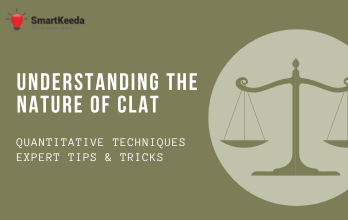
Given the multifaceted nature of this uncertainty, the significance of developing effective and well-practiced strategies for addressing tough questions in the upcoming CLAT 2025 examination cannot be overstated. The methodology to tackle such questions warrants thoughtful consideration, and herein lies the importance of acquiring proficient insights, this blog will exclusively revolve around revealing professional strategies for managing the intricate questions in the CLAT 2025 exam. The upcoming paragraphs will explain these strategies, explore coveted "pro tips" that can truly make a difference and useful insights for aspiring candidates.
With this foundation, let's begin the journey of exploring effective strategies and professional insights. Let's dive into this adventure with eagerness and readiness to discover valuable wisdom that will help navigate complex questions with skill and finesse.
Understanding the Nature of Tough Questions in CLAT Exam
Differentiating between Challenging and Regular Questions
Identifying Common Patterns in Tough CLAT Questions
The ability to dissect arguments, interpret intricate nuances, and navigate through multifaceted scenarios is frequently put to the test. Recognizing these recurring patterns allows aspirants to approach tough questions more strategically, armed with insights into the underlying framework.
Developing a Strategic Approach
Time Management: Allocating Time for difficult Questions
After this classification, it becomes paramount to apportion a judicious amount of time towards tackling the challenging questions. This allocation is grounded in the realization that intricate questions inherently necessitate more profound analysis and contemplation. Nevertheless, it's crucial to stick to predefined time limits to forestall the undue expenditure of time on particular individual questions, thus preserving equilibrium and fostering an approach that optimizes both precision and efficiency.
Prioritization: Selecting the Order of Confronting Complex Questions
Mastering Core Concepts
Two indispensable techniques that can undeniably augment your examination outcomes are the strategic deployment of skimming and scanning, complemented by the artful practice of annotating. A closer examination of these methodologies illuminates their potency in equipping candidates with the skills needed to navigate complex questions effectively.
Skimming and scanning: Quickly identifying key information in lengthy passages
In the art of skimming, candidates adroitly traverse the passage, capturing the overarching theme and essential constituents in a swift yet discerning manner. This entails a strategic focus on headings, subheadings, opening and concluding statements, and pivotal key points. The result of this strategic approach is the efficient extraction of critical information, enabling candidates to judiciously allocate their time during the examination and thereby enhancing their performance in the exam.
Having undertaken the comprehensive act of skimming, the strategic pivot to scanning becomes evident. Scanning, as a technique, enables candidates to promptly locate specific details embedded within the passage—be they numbers, names, or keywords. This streamlined approach eliminates the necessity for exhaustive re-readings, thereby heightening the precision and celerity of responses to questions that necessitate pinpointed information retrieval.
Marking important points while reading the question and answer choices
In instances where questions are intricately tied to the passage's content, the mindful employment of annotated points proves invaluable. By seamlessly referencing these marked elements, candidates expedite the process of identifying the correct response. This meticulous integration of annotations not only truncates the time investment per question but also affords an appreciable surge in overall efficiency.
Utilizing Logical Reasoning Strategies
Amidst the array of complex questions that pepper the examination, the strategic application of logical reasoning emerges as a powerful ally in enhancing both speed and accuracy, all while optimizing the judicious use of time. In this comprehensive framework, two strategies of paramount effectiveness come to the fore: the strategic utilization of deductive and inductive reasoning for analytical reasoning, and the adept application of the method of elimination.
Applying Deductive and Inductive Reasoning for Analytical Questions
In the CLAT exam, the logical reasoning section presents a dynamic range of questions that cleverly evaluate candidates' logical and analytical skills. These thoughtfully crafted questions offer an intellectually stimulating challenge, requiring candidates to showcase their analytical acumen and comprehensive understanding. Within this domain, two methodologies—deductive and inductive reasoning—stand out, providing versatile and strategic approaches to navigate the inherent complexity of these inquiries.
By adroitly employing both deductive and inductive reasoning, candidates equip themselves with a robust toolkit adept at unraveling the layers of complexity woven into analytical questions.
Using the Process of Elimination to narrow down options
Mastery of this technique involves methodically scrutinizing provided options and adroitly discerning contradictions or extremities that signal their exclusion. By thoughtfully juxtaposing the remaining options and conducting a comparative evaluation, candidates equip themselves to confidently deduce the ultimate solution. Revered for its efficiency and efficacy, the elimination method stands as an indispensable cornerstone within the logical reasoning toolkit.
Mastery of this technique involves methodically scrutinizing provided options and adroitly discerning contradictions or extremities that signal their exclusion. By thoughtfully juxtaposing the remaining options and conducting a comparative evaluation, candidates equip themselves to confidently deduce the ultimate solution. Revered for its efficiency and efficacy, the elimination method stands as an indispensable cornerstone within the logical reasoning toolkit.
Practicing with Mock Tests
Engaging in mock tests allows you to experiment with diverse approaches. These tests serve as canvases for refining methods, and identifying what works best for you. The mock test environment replicates actual exam challenges, preparing you for the pressures you'll face. Mock tests enable you to craft responses to demanding questions. You develop actionable strategies for confident, precise tackling. This controlled setting refines your problem-solving skills, creating a roadmap for the real exam. Trials cultivate time management, boosting efficiency and accuracy—essential for success.
As the adage goes, excelling in CLAT demands intense practice under exam-like pressure. Mock tests play a pivotal role, in replicating real challenges. Immersion in these simulations fosters adaptability, refining strategies under authentic conditions. Dedicating significant prep time to mock tests undoubtedly enhances CLAT readiness. Exposure to exam conditions boosts performance. As the exam nears, allocating time to mock tests is imperative. This practice builds confidence, and sharpens skills, enhancing CLAT success chances. more Info about CLAT Online Mock Test.
Enhancing Critical Thinking Skills

Author : Saurabh
Greetings! I'm Saurabh, an aspiring writer fueled by a deep passion for self-discovery through the written word. Along my journey, I have stumbled upon the enchanting realm of blog writing, which has become my true calling. As an avid wordsmith, nothing brings me greater joy than imparting knowledge and assisting students in their preparation for competitive exams. I invite you to join me on this thrilling expedition as we venture into the vast ocean of possibilities that writing offers. Stay connected to receive invaluable insights and expert guidance in every blog post. Together, let's unlock our full potential and embark on this educational adventure that awaits us!
FAQ’s
This understanding develops through consistent practice. With sufficient practice, you will naturally discern the complexity of a question and determine whether a given question poses a challenge or if you can confidently solve it. This level of intuitive understanding is a direct outcome of diligent practice.
It is prudent to begin by addressing questions of easy and moderate difficulty before progressing to more challenging ones.
Complex legal questions often revolve around hypothetical scenarios, Effectively addressing such intricate questions necessitates a comprehensive understanding of fundamental concepts. Furthermore, expanding one's reading habits to encompass a broader range of legal-related domains is imperative.
Skimming and scanning are the best approaches you can use for reading and comprehending lengthy passages.
When addressing complex legal scenarios in the CLAT exam, systematically analyze key components and information provided, ensuring their distinct separation for a comprehensive understanding.
Mock tests cultivate skills to analyze and approach challenging questions, improve time management, and boost confidence in addressing tough questions effectively.





